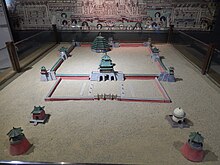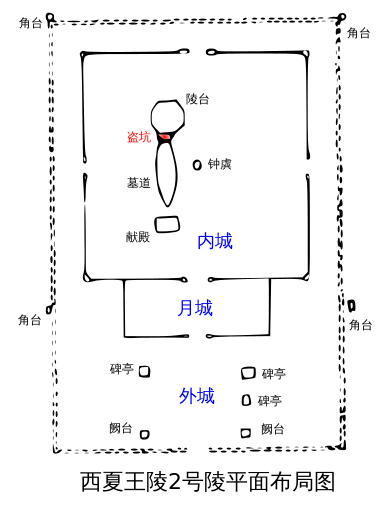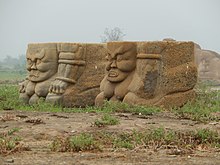266:(last emperor, reigned 1226–1227), probably because the Western Xia empire was destroyed by the Mongols before there was time to build their tombs. However, it has been suggested that Tomb 161, which is the largest other tomb in the tomb complex (165 metres long and 100 metres wide) is the joint imperial tomb for Emperors Shenzong and Xianzong. This tomb is situated about 200 metres south-west of Mausoleum 6 (for Emperor Chongzong), and although it is large compared with the other ordinary tombs, it is still smaller than the imperial mausoleums, and does not share the same complex layout as the imperial mausoleums. If Shenzong and Xianzong are buried in Tomb 161, then it would be the only mausoleum that does not follow the south-to-north order.
189:
146:
209:
365:
185:. It is positioned off-centre, in the north-west part of the inner enclosure, and is up to 30 metres across and 23 metres in height. There are holes in the tomb mounds that would have originally supported wooden beams, and as very large numbers of tiles have been found in each mausoleum, it is believed that the surviving mounds are the cores for a more substantial architectural monument, coated with bricks and with tiled eaves and decorative sculptures at each level.
35:
961:
343:
321:
300:
973:
153:
The area occupied by the
Western Xia tombs runs from south-west to north-east along the eastern edge of the Helan Mountains, and is about 12 km in length, and up to 2.5 km in width. The nine imperial mausoleums are arrayed from south to north over a distance of about 10 km, with the earliest emperors
251:(7th emperor, reigned 1206–1211). This area was developed for industrial use during the 1970s, and part of Mausoleum 7 and most of Mausoleums 8 and 9 were built over, although the tomb mounds still survive. The buildings from the 1970s have now all been demolished.
216:
Mausoleums 3 and 4 are about 4 km further north, with
Mausoleum 3 at the eastern edge of the tomb area, and Mausoleum 4 situated about 2 km to the west, close to the side of the mountains. It is believed that Mausoleum 3 is occupied by
196:
Mausoleums 1 and 2 are situated close together at the southern tip of the tomb complex, and are the two largest tombs, with their outer enclosure both measuring 340 × 224 metres. These two are believed to be occupied by the grandfather
101:
ethnic group, about which little is currently known. Of current excavations, only the No.3 mausoleum has been adequately excavated and researched. This mausoleum is attributed to
Western Xia's first emperor
839:
1046:
992:
130:
81:
Some 17,000 m (180,000 sq ft) have so far been excavated, and efforts are underway to secure and preserve the remains of this poorly understood era.
884:
1041:
1051:
106:, born Li Yuanhao (1003–1048), has been determined as a pavilion-tower construction fusing both traditional mausoleum and temple styles with
904:
703:
188:
816:
157:
Each mausoleum has a similar layout (see plan of
Mausoleum 2 below), in general comprising a rectangular outer enclosing wall (
1031:
632:
567:
17:
696:
447:
396:
248:
233:
430:
335:
259:
255:
244:
218:
103:
744:
729:
413:
379:
240:
229:
876:
529:
475:
357:
222:
51:
1036:
809:
364:
62:. This burial complex lies some 40 km (25 mi) westward from capital city of the Western Xia, the
689:
263:
181:角闕) at the four corners. The solid tomb mound built over the site of the burial is constructed from
977:
930:
802:
342:
759:
754:
320:
299:
228:
About 2 km further north are
Mausoleums 5 and 6, which are believed to be occupied by Emperors
145:
165:鵲臺) at the south end, then one or more pavilions (usually a pair) housing memorial steles (
113:
The
Western Xia capital city and the burial complex eluded early 20th century explorers of
8:
861:
739:
922:
912:
501:
480:
208:
724:
661:
628:
563:
533:
965:
848:
493:
489:
93:
dynasty existed between 1038 and 1227, when it was conquered by the
Mongols under
782:
773:
47:
894:
133:, who recorded the site in an aerial photograph, published in 1938 in his book
1025:
1007:
994:
778:
734:
665:
98:
889:
182:
118:
114:
94:
649:
46:
occupy an area of some 50 km (19 sq mi) at the foot of the
866:
856:
712:
173:月城) in front of the entrance to a square or rectangular inner enclosure (
122:
90:
59:
34:
601:
Collection of stele fragments unearthed from the
Western Xia mausoleums
505:
126:
239:
About 3 km further north are a group of three mausoleums for
Emperors
154:
buried at the south, and the later emperors buried towards the north.
681:
592:
313:
292:
202:
198:
55:
530:"Xixia (Western Xia) Mausoleums: Excavation and Protection Underway"
497:
835:
107:
71:
825:
794:
254:
There are no mausoleums for the last three
Western Xia emperors,
75:
221:(1st emperor, reigned 1038–1048) and Mausoleum 4 is occupied by
58:
and 250 tombs of imperial relatives and officials of China's
1047:
Major National Historical and Cultural Sites in Ningxia
205:) of Li Yuanhao, the first Emperor of the Western Xia.
547:
54:of northwestern China, and include nine imperial
1023:
129:. During modern times, it was first reported by
614:
612:
610:
236:(4th emperor, reigned 1086–1139) respectively.
810:
697:
562:]. Dongfang chubanshe. pp. 163–174.
607:
469:
467:
817:
803:
704:
690:
627:]. Dongfang chubanshe. pp. 6–38.
473:
524:
522:
464:
587:
585:
583:
581:
579:
207:
144:
33:
14:
1042:National archaeological parks of China
1024:
711:
603:]. Wenwu chubanshe. pp. 3–11.
519:
476:"The Tangut Royal Tombs near Yinchuan"
262:(9th emperor, reigned 1223–1226), and
247:(6th emperor, reigned 1193–1206), and
140:
798:
685:
576:
232:(3rd emperor, reigned 1068–1086) and
1052:Buildings and structures in Yinchuan
972:
618:
553:
474:Steinhardt, Nancy Shatzman (1993).
24:
824:
647:
591:
258:(8th emperor, reigned 1211–1223),
243:(5th emperor, reigned 1139–1193),
225:(2nd emperor, reigned 1048–1068).
187:
169:碑亭), then a rectangular barbican (
25:
1063:
161:外城), with a pair of gate towers (
971:
960:
959:
363:
341:
319:
298:
97:. The empire was founded by the
745:Western Xia rulers family tree
730:Mongol conquest of Western Xia
641:
619:Xu, Cheng; Du, Yubing (1995).
554:Xu, Cheng; Du, Yubing (1995).
378:Li Bingchang 李秉常 (1061–1086),
13:
1:
395:Li Qianshun 李乾順 (1083–1139),
356:Li Liangzuo 李諒祚 (1047–1068),
149:Reconstruction of Mausoleum 3
76:Ningxia Hui Autonomous Region
52:Ningxia Hui Autonomous Region
458:
429:Li Chunyou 李純佑 (1177–1206),
412:Li Renxiao 李仁孝 (1124–1193),
334:Li Yuanhao 李元昊 (1003–1048),
7:
446:Li Anquan 李安全 (1170–1211),
131:Wulf-Dieter Graf zu Castell
10:
1068:
625:The Western Xia mausoleums
560:The Western Xia mausoleums
84:
955:
939:
921:
903:
875:
847:
833:
768:
720:
212:Stele bases of Tomb no. 3
29:Historical tombs in China
1032:Western Xia architecture
177:陵城), with watch towers (
931:Chinese Islamic cuisine
1008:38.43500°N 105.98722°E
947:Western Xia mausoleums
755:Fashion in Western Xia
750:Western Xia mausoleums
213:
193:
150:
44:Western Xia mausoleums
39:
211:
191:
148:
70:, what is modern-day
37:
650:"161号陪葬墓应为西夏"10号"帝陵"
450:(reigned 1206–1211)
433:(reigned 1193–1206)
416:(reigned 1139–1193)
399:(reigned 1086–1139)
382:(reigned 1068–1086)
360:(reigned 1048–1068)
338:(reigned 1038–1048)
1037:Mausoleums in China
1013:38.43500; 105.98722
1004: /
940:Visitor attractions
740:Western Xia coinage
192:Plan of Mausoleum 2
141:Imperial mausoleums
60:Western Xia dynasty
913:Ningxia University
214:
194:
151:
40:
38:Tombs nos. 1 and 2
987:
986:
792:
791:
456:
455:
448:Emperor Xiangzong
397:Emperor Chongzong
110:characteristics.
74:, capital of the
18:Western Xia tombs
16:(Redirected from
1059:
1019:
1018:
1016:
1015:
1014:
1009:
1005:
1002:
1001:
1000:
997:
975:
974:
963:
962:
819:
812:
805:
796:
795:
706:
699:
692:
683:
682:
677:
676:
674:
672:
645:
639:
638:
616:
605:
604:
589:
574:
573:
551:
545:
544:
542:
540:
526:
517:
516:
514:
512:
490:Brill Publishers
471:
431:Emperor Huanzong
367:
345:
336:Emperor Jingzong
323:
302:
269:
268:
219:Emperor Jingzong
21:
1067:
1066:
1062:
1061:
1060:
1058:
1057:
1056:
1022:
1021:
1012:
1010:
1006:
1003:
998:
995:
993:
991:
990:
988:
983:
951:
935:
917:
899:
871:
843:
829:
823:
793:
788:
783:Tangut numerals
774:Tangut language
764:
716:
710:
680:
670:
668:
646:
642:
635:
617:
608:
590:
577:
570:
552:
548:
538:
536:
528:
527:
520:
510:
508:
498:10.2307/1523201
472:
465:
461:
414:Emperor Renzong
380:Emperor Huizong
316:李德明 (981–1032)
295:李繼遷 (963–1004)
143:
87:
48:Helan Mountains
30:
23:
22:
15:
12:
11:
5:
1065:
1055:
1054:
1049:
1044:
1039:
1034:
985:
984:
982:
981:
969:
956:
953:
952:
950:
949:
943:
941:
937:
936:
934:
933:
927:
925:
919:
918:
916:
915:
909:
907:
901:
900:
898:
897:
895:Tengger Desert
892:
887:
881:
879:
873:
872:
870:
869:
864:
859:
853:
851:
845:
844:
834:
831:
830:
822:
821:
814:
807:
799:
790:
789:
787:
786:
776:
769:
766:
765:
763:
762:
757:
752:
747:
742:
737:
732:
727:
721:
718:
717:
709:
708:
701:
694:
686:
679:
678:
660:(1): 119–122.
656:(in Chinese).
640:
633:
606:
575:
568:
546:
534:People's Daily
518:
462:
460:
457:
454:
453:
451:
444:
441:
437:
436:
434:
427:
426:Zhuangling 莊陵
424:
420:
419:
417:
410:
407:
403:
402:
400:
393:
390:
386:
385:
383:
376:
373:
369:
368:
361:
358:Emperor Yizong
354:
351:
347:
346:
339:
332:
329:
325:
324:
317:
311:
308:
304:
303:
296:
290:
287:
283:
282:
279:
276:
273:
223:Emperor Yizong
201:) and father (
142:
139:
86:
83:
28:
9:
6:
4:
3:
2:
1064:
1053:
1050:
1048:
1045:
1043:
1040:
1038:
1035:
1033:
1030:
1029:
1027:
1020:
1017:
980:
979:
970:
968:
967:
958:
957:
954:
948:
945:
944:
942:
938:
932:
929:
928:
926:
924:
920:
914:
911:
910:
908:
906:
902:
896:
893:
891:
888:
886:
883:
882:
880:
878:
874:
868:
865:
863:
860:
858:
855:
854:
852:
850:
846:
841:
837:
832:
827:
820:
815:
813:
808:
806:
801:
800:
797:
784:
780:
779:Tangut Script
777:
775:
772:
771:
767:
761:
758:
756:
753:
751:
748:
746:
743:
741:
738:
736:
735:Tangut people
733:
731:
728:
726:
725:Song–Xia wars
723:
722:
719:
714:
707:
702:
700:
695:
693:
688:
687:
684:
667:
663:
659:
655:
651:
644:
636:
634:7-5060-0673-1
630:
626:
622:
615:
613:
611:
602:
598:
594:
588:
586:
584:
582:
580:
571:
569:7-5060-0673-1
565:
561:
557:
550:
535:
531:
525:
523:
507:
503:
499:
495:
491:
487:
483:
482:
477:
470:
468:
463:
452:
449:
445:
442:
439:
438:
435:
432:
428:
425:
422:
421:
418:
415:
411:
408:
405:
404:
401:
398:
394:
391:
388:
387:
384:
381:
377:
374:
371:
370:
366:
362:
359:
355:
352:
349:
348:
344:
340:
337:
333:
330:
327:
326:
322:
318:
315:
312:
309:
306:
305:
301:
297:
294:
291:
288:
285:
284:
280:
277:
274:
271:
270:
267:
265:
261:
257:
252:
250:
246:
242:
237:
235:
231:
226:
224:
220:
210:
206:
204:
200:
190:
186:
184:
180:
176:
172:
168:
164:
160:
155:
147:
138:
136:
132:
128:
124:
120:
116:
111:
109:
105:
100:
96:
92:
82:
79:
77:
73:
69:
65:
61:
57:
53:
49:
45:
36:
32:
27:
19:
989:
976:
964:
946:
890:Yellow River
749:
671:November 24,
669:. Retrieved
657:
653:
643:
624:
620:
600:
596:
559:
555:
549:
537:. Retrieved
509:. Retrieved
485:
479:
443:Kangling 康陵
409:Shouling 壽陵
392:Xianling 顯陵
375:Xianling 獻陵
253:
238:
227:
215:
195:
183:rammed earth
178:
174:
170:
166:
162:
158:
156:
152:
134:
119:Pyotr Kozlov
117:, including
115:Central Asia
112:
95:Genghis Khan
88:
80:
67:
63:
43:
41:
31:
26:
1011: /
999:105°59′14″E
713:Western Xia
648:岳键 (2007).
492:: 369–381.
331:Tailing 泰陵
310:Jialing 嘉陵
123:Aurel Stein
91:Western Xia
64:Xingqing fu
1026:Categories
996:38°26′06″N
597:西夏陵墓出土残碑粹编
593:Li, Fanwen
353:Anling 安陵
289:Yuling 裕陵
127:Sven Hedin
56:mausoleums
905:Education
877:Geography
770:Language
666:1674-1331
459:Footnotes
314:Li Deming
293:Li Jiqian
249:Xiangzong
234:Chongzong
203:Li Deming
199:Li Jiqian
175:lingcheng
135:Chinaflug
966:Category
862:Politics
836:Yinchuan
760:Baisigou
654:宁夏师范学院学报
595:(1984).
539:July 15,
511:July 14,
481:Muqarnas
278:Occupant
260:Xianzong
256:Shenzong
245:Huanzong
171:yuecheng
159:waicheng
108:Buddhist
104:Jingzong
72:Yinchuan
68:Xingqing
978:Commons
923:Cuisine
867:Economy
857:History
849:General
840:capital
826:Ningxia
506:1523201
484:(PDF).
241:Renzong
230:Huizong
179:jiaoque
167:beiting
85:History
50:in the
885:Cities
828:topics
715:topics
664:
631:
566:
504:
281:Photo
163:quetai
99:Tangut
623:[
599:[
558:[
502:JSTOR
673:2014
662:ISSN
629:ISBN
564:ISBN
541:2009
513:2009
275:Name
264:Modi
125:and
89:The
42:The
621:西夏陵
556:西夏陵
494:doi
272:No.
66:or
1028::
658:28
652:.
609:^
578:^
532:.
521:^
500:.
488:.
486:10
478:.
466:^
440:9
423:8
406:7
389:6
372:5
350:4
328:3
307:2
286:1
137:.
121:,
78:.
842:)
838:(
818:e
811:t
804:v
785:)
781:(
705:e
698:t
691:v
675:.
637:.
572:.
543:.
515:.
496::
197:(
20:)
Text is available under the Creative Commons Attribution-ShareAlike License. Additional terms may apply.



